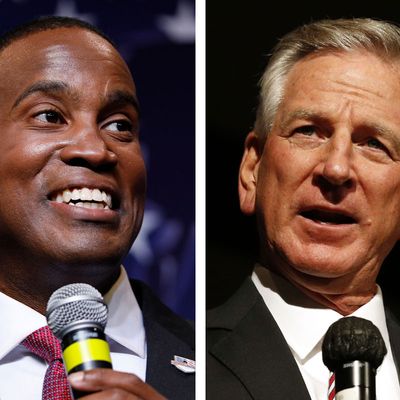
Going into the current election cycle, Senate Republicans were in one respect on even ground with Democrats: Each party held two seats up for election in 2020 in states that the other party had won in 2016. In that year, famously, no Senate candidates broke serve by winning a state their presidential candidate lost. So in theory, Democrats Doug Jones (Alabama) and Gary Peters (Michigan) began the cycle in some danger, as did Republicans Cory Gardner (Colorado) and Susan Collins (Maine). With Republicans already holding a three-seat majority in the Senate, and with Jones looking like the most vulnerable incumbent from either party by a country mile, GOP control of the Upper Chamber looked relatively secure.
On the other hand, Republicans were defending nearly twice as many seats overall (23 to 12), and as the 2020 election approached the political evolution of some states and the overall Biden lead over Trump turned the landscape purple and eventually light blue. The Cook Political Report shows an incredible 12 Republican-held seats as being in competitive (toss-up or leaning one way or the other) states, and the same two Democratic seats as always being vulnerable (Alabama and Michigan).
For Republicans on the defensive across so broad a Senate landscape, it is essential they win those two Democratic seats to offset likely losses on their own turf. The following is an assessment of their chances.
Alabama: Can Doug Jones pull off a second miracle?
Former U.S. Attorney Doug Jones won his Senate seat in a December 2017 special election triggered by Jeff Sessions’s resignation to become Donald Trump’s attorney general. The seat was at first occupied by interim appointed Republican senator Luther Strange (whose appointment created suspicions of a corrupt bargain since Strange was state attorney general and Governor Robert Bentley was under investigations for abuse of power). Strange was then upset in a Republican primary by Christian Right warhorse and twice-defrocked State Supreme Court judge Roy Moore. Judge Roy added to his customary handicaps of theocratic rhetoric and poor fundraising by attracting multiple allegations of predatory sexual behavior (and even assault) toward very young women.
Jones wasn’t just an accidental senator, though; he ran a smart campaign that didn’t simply pursue the old southern Democratic template of running as far to the right as possible. He mobilized Black voters in particular, and pulled off the upset despite Donald Trump’s vocal support for Judge Roy (Trump had supported Strange in the primary).
That was in an off-year special election, though. Jones has had a bull’s-eye on his back from the day he beat Moore given the certainty that Trump would win big in Alabama in 2020 (he carried the state by 27 points in 2016) and the growing prevalence of straight-ticket voting everywhere. The Democrat’s Senate voting record has been moderate and as bipartisan as you can get these days, but he has bucked Trump on a number of key issues including the rollback of environmental regulations, legislation to override administration efforts to gut Obamacare, a 20-week abortion ban, and the Kavanaugh confirmation. Most significantly, Jones voted to remove Trump from office on both of the impeachment charges brought earlier this year, which in the eyes of many observers cooked his goose while inspiring Democratic admiration.
The battle to choose a Republican opponent to Jones featured former opponent Roy Moore (who never got any traction this time), congressman Bradley Byrne (who ultimately finished third in the primary, missing the runoff the state requires when no one wins a majority), former senator Jeff Sessions in an attempted comeback, and former Auburn football coach and first-time candidate Tommy Tuberville. It became a competition to become the Trumpiest candidate, and the president’s endorsement of Tubs (as he is known) was crucial, as I acknowledged at the time:
Tuberville, who is sort of Roy Moore without the creepy taste for young women, is slavishly devoted to Trump. But in a contest that revolved around the MAGA altar, the president could have remained neutral if not for his insatiable taste for revenge against Sessions. The two men ran nearly even in the first primary (with another Trump idolator, Bradley Byrne, finishing a respectable third) and Sessions might have had a fighting chance in the March 31 runoff. That’s probably not the case now.
Sure enough, Tubs won the runoff handily, and has run a low-profile campaign against Jones, relying on Trump to pull him across the finish line. Tuberville isn’t going to strike anyone as a great or thoughtful public servant, and he’s run into some bad press over a tax-exempt foundation he created that hasn’t exactly directed all of its proceeds to the veterans it supposedly serves.
There hasn’t been much public polling in Alabama, but the latest survey from Auburn University at Montgomery shows Tuberville leading Jones by 12 points (54-42). The same poll showed Trump leading Biden in Alabama by 20 points (57-37), which indicates that the sagging support Trump is exhibiting in several other southern states is still reasonably firm in the Heart of Dixie (as Alabama still unofficially calls itself). It may take a Trump collapse or a Tuberville descent into further slack-jawed exhibitions of egregious ignorance to enable a second Jones victory.
Michigan: Will John James’s second Senate run work better against Gary Peters?
Most of the Republican chest-beating over their performance in the 2018 midterms involved their success in defending and even expanding (by two net seats) their majority, which was only impressive if you failed to understand the vast advantage they had in the underlying landscape. But there was at least one 2018 GOP loser who raised eyebrows: Michigan’s John James, who lost to Democratic veteran Debbie Stabenow by six points.
James was a Republican strategist’s dream candidate, especially in the Trump Era: a Black entrepreneur and Iraq veteran who didn’t run away from his party and managed to attract robust financial backing. So it wasn’t surprising that he launched a comeback campaign against Michigan’s other Democratic senator, Gary Peters, who was famous for being not very famous among his constituents. In a 2019 survey, over a third of Michigan voters said they’d never heard of their junior senator. And James was once again a fundraising machine, out-raising Peters early on in a year when most Democrats were piling up huge money advantages.
James has campaigned this time around as a problem-solving moderate, but he is still haunted by a comment he made in 2018 that he was a “2,000 percent” Trump supporter. Although Trump won Michigan by an eyelash in 2016 (just over 10,000 votes, winning 47.5 percent of the total), he has been trailing Biden pretty badly this year in Michigan polling, which is more abundant and of higher quality than the 2016 surveys. Biden currently leads by 7.8 percent in the FiveThirtyEight polling averages for Michigan, and a particularly compelling survey was provided by the gold-standard New York Times/Siena outfit, showing Biden up 48-40.
That same poll, however, showed Peters leading James by just one point (43-42). James is running ahead of Trump among seniors, near-seniors, and even rural voters.
In the end, Trump may drag James down to defeat. He’s trailing Peters in the RealClearPolitics polling averages by 6 percent — about the same margin as his 2018 loss. But Michigan can be funky, as we learned four years ago. His party may be handing John James an anvil by making him run on a ticket with Donald Trump, but it really needs him to outperform the president to save Mitch McConnell’s gavel — and bacon.






























